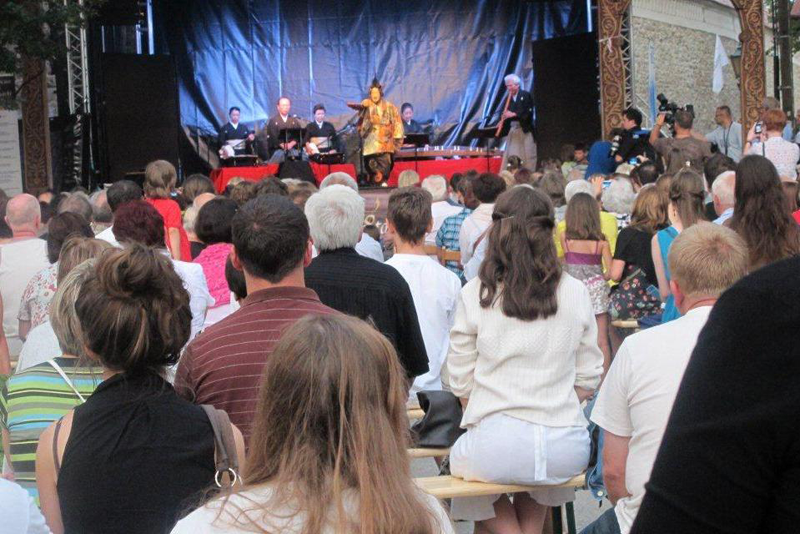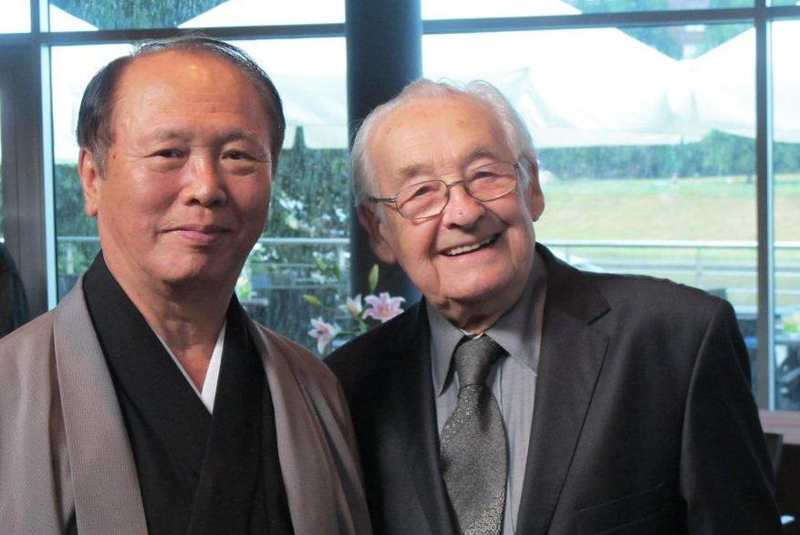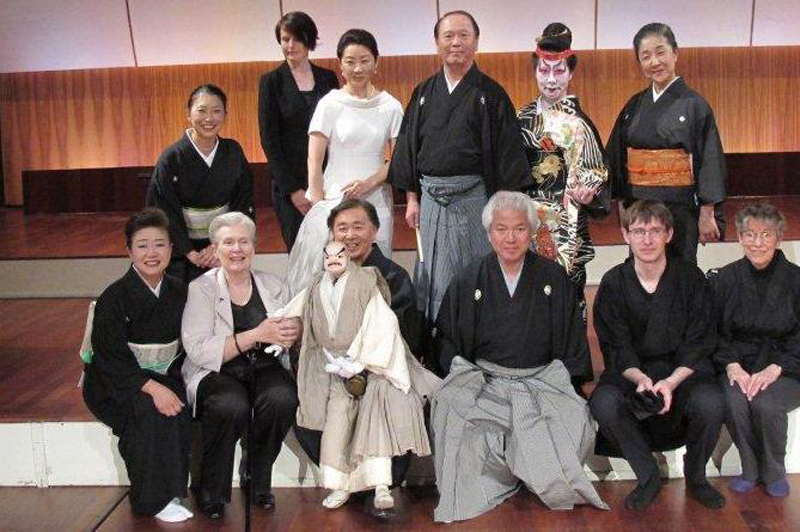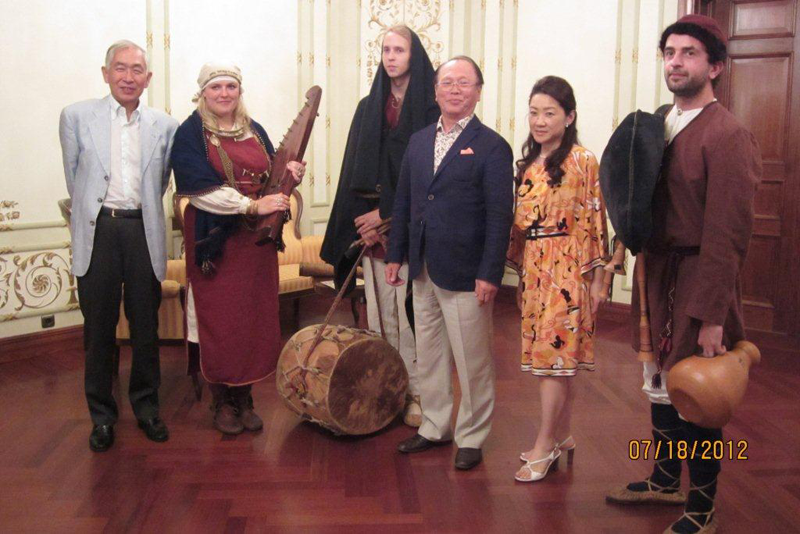Report on Performances in Poland and Latvia in 2012
(from “Hogaku no Tomo”, January 2013)
Last year, just after the Great East Japan Earthquake and Tsunami, I performed in Poland. There’s a report of that trip in “Hogaku no Tomo” and also in this blog (see the entries dated March 31 through April 5, 2011 below). One result of last year’s performance was that I was again invited to Poland. I was asked to perform there in July of this year.
Stary Sacz, Poland
In a quiet old village called Stary Sacz, about 120 kilometers south of Krakow, an annual early music festival is held. This year’s festival was titled Music Contrasts: Europe and Asia. The purpose of this festival was to introduce Asian culture and customs through concerts. The organizers had started planning this year’s festival a year ago. Last year, for the first time, performers came from China and Iran. This year, performers came from Japan and India. The Artistic Director of the festival decided to invite us after he saw our performance in Krakow in July 2011. When my friend who was living in Krakow contacted me last year about this, I told him that I would be willing to participate.
The participants from Japan this time included three from shinnai, two from Noh, a Kuruma Ningyo puppeteer, a Japanese traditional dancer, a shakuhachi player, a koto player, and an interpreter, for a total of ten people.
I dramatized the work we performed based on the shinnai work Hidakagawa Iriai Zakura, combining it with the Noh and Japanese dance settings of the same story, generally referred to as Dojoji. The part of the story that we performed included the section describing Kiyohime running after Anchin, then leaping into the Hidaka River, swimming across, and finally attacking the bell in which Anchin is hiding. The underlying theme of the dramatization was to show the charm and beauty of the Japanese traditional arts through a collaboration of shinnai narrative song (joururi) with traditional dance, puppetry, Noh, shakuhachi, and koto.
Performing shinnai overseas
When I perform Japanese traditional arts overseas, my concept of the performance changes according to the situation. I think that it is very, very important to perform old works in their pure form. In my opinion, when I perform these wonderful old pieces, it gives the audience a valuable opportunity to understand Japan. In addition, it is very important that the performance be enjoyable, and that the contents are easy to understand. It is my mission as an ambassador of Japanese culture to spread understanding of Japanese culture. To achieve that purpose, the audience needs supertitles that provide a detailed explanation of the contents of the works being performed, or else someone summarizing the story of the work prior to its being performed. In Japan, we have such aids for the audience. Nowadays, it’s accepted that Japanese have about the same level of knowledge of these old works as non-Japanese.
I am searching for enjoyable material that is not so difficult to understand, which I can then set in shinnai style so that audiences can get a deeper understanding of the method by which traditional performers perform the old works. Although I’ve heard that in Europe, works that are difficult to understand, or which do not have a good story, or conceptual works are acceptable to audiences, I don’t have the ability to compose or perform such works, and I don’t want to try. I want my performances to express the beauty of Japanese culture.
In order for audiences to have a good understanding of the works that I perform, I’ve used the local language many times when performing shinnai. Up to now, I’ve performed in about forty countries. In about half of them, I’ve used the local language in at least part of my performance. Whether I do that depends on the work I’m performing. But as much as possible, I include some sentences in the local language in my joururi. I’m no linguist, and so this is hard for me, but I’ve enjoyed it.
However, on this trip, the Polish language was too difficult. People say that it’s the most difficult language in the world. I gave up trying to use it in the performance. I also gave up trying to use the local languages in Russia, Estonia, Latvia, and Lithuania because their languages are so difficult.
Perhaps I have wandered too far from my purpose of reporting on this trip that included Stary Sacz. In Stary Sacz, I could fulfill my mission to the traditional Japanese arts because in this friendly small town, I had good communication with the audience. As an ambassador for Japanese culture, I was able to introduce several traditional Japanese arts. Occasionally, I get e-mail from people I met in Stary Sacz. They tell me that they want me to go back again to perform there.
While we were in Stary Sacz, in addition to the performance, there was a seminar in which I explained about the shamisen and demonstrated its sound.
I didn’t see any other Japanese in Stary Sacz besides our group. I met a teenage Polish girl, around 15 years old, who was studying Japanese. The people there have a great interest in Japan.
Krakow, Poland
From Stary Sacz, we were driven to Krakow. It took about 1 1/2 hours. Krakow was the capital when Poland was ruled by a king. Even now, a part of Krakow retains the atmosphere of the Middle Ages. Many tourists visit the old part of the city. When I was there in March 2011, it was very cold, and we didn’t do much sightseeing. This time, it was July. People told us that this is the best season for visiting Krakow. Day and night, when I had free time, I went sightseeing. Last year, I performed at the Manggha Centre of Japanese Art and Technology, and the performance this year was also held there. This year’s performance commemorated a visit to this theater ten years ago by the Emperor and Empress of Japan. The commemorative event was sponsored by the Manggha Centre.
The performance was held on July 11, which happens to be my birthday. Before the performance, the chef of the Centre’s restaurant presented me with a birthday cake. I was moved by this warm gesture in a foreign country.
Our performance was sold out. We performed the same works as in Stary Sacz. For the curtain call, each group of artists improvised a brief performance showing off their genre.
People at the reception after the performance included the Mayor of Krakow and Ambassador Makoto Yamanaka and his wife, in addition to many people who are active in arts related to Japan. The famous movie director, Andrzej Wajda, was also there. Wajda directed many movies, including Kanal, Ashes and Diamonds, and Katyn. He has many fans all over the world. His movies are realistic. I am a fan of Wajda’s, and had been looking forward to meeting him. Wajda likes Japanese things, and ranks Japanese culture very high. He told me that he had studied Nihonga in Kyoto, and that he continues to paint.
Unfortunately, because of the language barrier, our conversation had to be through an interpreter. Even so, I could understand when he told me that he had been looking forward to our performance. We performers from Japan were all very happy to hear that, and it is a good memory for us.
My birthday this year was really special. I’ll never forget the experiences of that day–but I’ve forgotten how old I am.
Late that same night, actually it was the next day, I was woken up at 3 a.m. for our 4 a.m. departure. We were driven by bus to the Warsaw airport. We went by bus in order to save money. We arrived in Riga, Latvia, after a 1 1/2 hour flight.
Riga, Latvia
Last October (2011), I performed with the Kuruma Ningyo puppet troupe in Latvia. At that time, I got to know the Japanese Ambassador, Takashi Osanai, and his wife. After that, I occasionally had dinner with them in Kagurazaka. The performance this year in Riga was a result of that relationship. We realized that it isn’t far from Poland to Latvia, so it was possible for our group to drop in at Riga on the way back to Japan from Poland.
The performance in Riga wouldn’t have been possible without a lot of help and support from the Ambassador. I appreciate his and his wife’s great kindness to us. I was deeply moved and impressed by their generous support.
July 13 was the day of our performance. We had to have a rehearsal in the afternoon and perform in the evening even though we were still tired from having arrived late the previous afternoon from Poland. If I were young, I could do this without any problem, but as I am not so young, I couldn’t conceal my tiredness. When I had some free time, I rested for a while, but I also had to prepare for the performance.
The works we performed were almost the same as we had done in Poland. (Incidentally, the works I performed with the Kuruma Ningyo troupe in 2011 were Yaoya O’shichi and Sakura Sogoro: Jinbei no Watashi.) This time, the big hall was completely filled. I’m grateful that the audience was quiet throughout our performance.
The people in Poland and Latvia seem deeply interested in Japan. Especially they seem to have a deep respect for Japanese culture and want to learn about it and experience it more. Surely they love Japan.
The applause was so enthusiastic at the end of our performance that we were given a curtain call. Ambassador Osanai and his wife were very happy with the outcome. We too were very happy and also relieved that it had gone well.
The next day, some of the performers returned to Japan, while others stayed to enjoy vacationing in Latvia.
Estonia, Latvia, and Lithuania
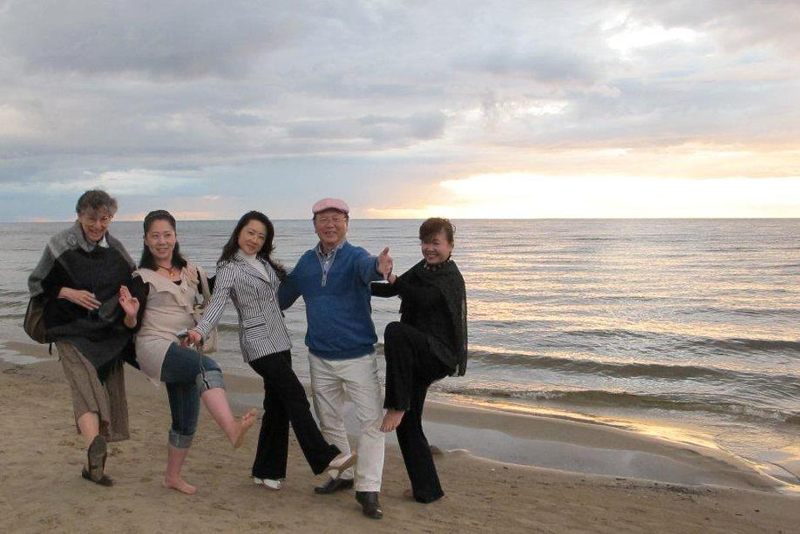
By the Baltic sea in the light of the setting sun, with the wife of the Japanese Ambassador to Latvia
The three Baltic States of Estonia, Latvia, and Lithuania all face the eastern shoreline of the Baltic Sea. Each of these countries is about the size of Hokkaido. The land is generally flat, and there are no high mountains–the highest is only about 300 meters. There are many rivers, and more than a thousand ponds and lakes. Because these three countries are small, they’ve had a difficult time historically. In 1991, they became independent of Soviet Russia, and in 2004, they joined NATO and the EU. The climate in all three is very similar, but their nationality, language, culture, and history are different.
Baruto, the ozeki sumotori, comes from Estonia. In Lithuania, Jews were persecuted by the Nazis at the time of World War II. A Japanese diplomat in Lithuania, Chiune Sugihara, issued transit visas to Lithuanian Jews, thus rescuing more than 6,000 people. His wonderful deeds are still remembered.
Last fall (2011), I performed in all three Baltic States, together with the Kuruma Ningyo troupe, traveling around by bus.
Latvia is the most wonderful of these three countries. Riga, the capital, is especially fashionable. Riga’s historical area is a UNESCO World Heritage Site, and the city has many good restaurants. Young people are attracted to the charm of Riga.
Few travel guides available in Japan introduce Riga, and we saw almost no other Japanese tourists while we were there. Actually, I would like to keep Riga as my own special secret.
We stayed five days in this country. It was so charming that we felt that we would like to stay there to live. We enjoyed learning about their history and experiencing their culture. Ambassador Osanai and his wife were extremely kind to us, and made possible many special experiences. They took us to many wonderful places that we would never have known about otherwise. It would be impossible for ordinary tourists to find these places. We had a wonderful holiday in Latvia.
Concluding Comments
I have performed in more than forty countries. In almost all of them, I felt that the people there were friendly toward Japan. They seemed to have a deep interest in and respect for Japanese history, culture, and traditions. Also, many people in these countries have studied some aspect of Japanese traditional culture, and so they understand it. Many students whom we met want to study more about Japan and to visit Japan.
In contrast, young Japanese nowadays don’t understand Japanese traditional culture. They don’t know about the high quality of Japanese traditions. As a result, they cannot have pride and self-confidence.
I think that the Japanese people are the best in the world, but, on the other hand, there is no other nation in which, like Japan, the people do not know and appreciate their own traditions. I am very sad about that.
I’ve heard that when Japanese people go abroad, they have trouble answering questions about the Japanese traditional arts. That’s terrible. I think that such people cannot be called truly international people.
In this chaotic and uncertain world, a stable spirit and a warm heart are needed. In that context, it is my opinion that the value of the cultural arts should not be forgotten. I expect that we, as traditional performers, should now become more active, and that the government should support us.
Tsuruga Wakasanojo XI

